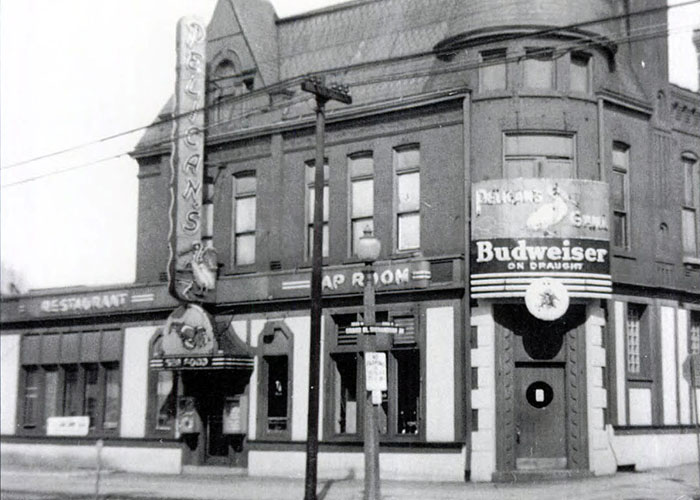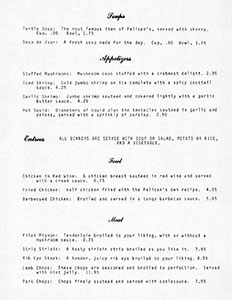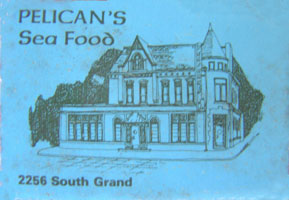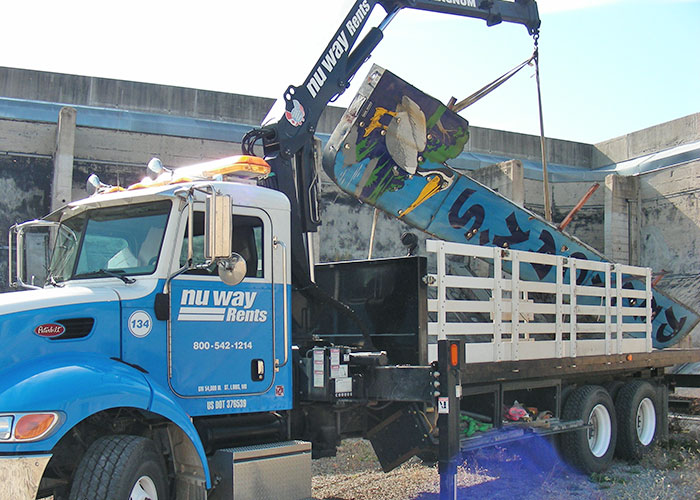|
Pelican's
James Pelican's eating place was housed in a
three-story red brick building at the northeast corner of Grand and
Shenandoah. The structure, distinguished by its German-style turret,
became a St. Louis City landmark in 1976. In recent years, the
historic building has stood vacant, as in the 2011 photo below. But
memories of turtle soup and a neon pelican sign are not easily erased.
The core of the building was constructed sometime prior to 1875 ― by that time people were already eating and drinking there. Three years later, one C. Becker was given a building permit to construct an addition to the "existing saloon dwelling." In 1895, Anton Griesedieck, of the Griesedieck Brothers Brewing family, spent $4000 to build an addition, including the turret on the corner. The enlarged venue was managed by Carl Anschuetz, a former head waiter and manager at Tony Faust's, as Anschuetz Garden and Restaurant. According to a pamphlet written about the neighborhood in 1915, the German restaurant was a model establishment.
In 1913, Anschuetz opened a second restaurant, the Mission Inn, three blocks south at Grand and Magnolia. After operating both establishments for several years, he gave up management of the Grand and Shenandoah venue. Anschuetz Garden became Shenandoah Garden. In the 1920s, in addition to offering food and drink, it provided musical entertainment and served as an open-air movie theater. In December of 1922, the venue featured the Royal Garden Jazz Band and "Silver Wings," a screen drama starring Mary Carr.
By 1937, the Shenandoah Garden was operated by
Tony Bertig and offered chicken dinners, fine barbecue and nightly
entertainment.
James Pelican, born Demetrios Spiros Pelekanos in Athens, Greece in 1893, came to America in 1906. By 1917, he was working in St. Louis as a waiter at the Palmís Cafe at 3106 South Grand. By 1929, Pelican had purchased the Conservatory Candy Shop at 2304 South Grand. In 1930, he married Catharine Badunnis of St. Louis, and the couple ran the Conservatory Candy Company as president and vice-president until at least 1933.
By 1936, Pelican had
converted his 2304 South Grand candy shop into a restaurant, called Jimmie Pelicanís
Cafe.
Pelican's cafe was a success and became well known throughout the area. Before long, he was looking for more space and more parking. In January of 1938, he applied for a building permit for the "alteration and addition to a two and a half story store at 2256 South Grand." James Pelican had purchased Shenandoah Garden, which was across the street from his cafe. On May 17, 1938, he reopened it as Pelican's Grill.
Pelican's was in full swing by the spring of 1938, including quality entertainment, which moved outdoors to a summer garden when the weather warmed up.
By the time Pelican
acquired the building, Grand and Shenandoah was no longer quite the
elegant edge of the city it had been 20 years earlier. Whether for
this reason or just because he liked it, Pelican installed a
garish two-story blue neon sign, featuring a big yellow and
white pelican, just above the lobster which hung over his South Grand
dining room entrance.
Pelican's main
dining room seated 125 customers. Perhaps the most outstanding feature of the
restaurantís interior was a mural that covered the length of one
wall. It was painted in the early 1950s, but was very
much 1930s.
Pelican hired Thomas Pisani as his chef. Pisani was born in St. Louis in 1905. Before joining Pelican, he worked at a resort near Hollywood, Florida in 1932, and before that, at the Sunset Inn in St. Louis. Pisani, who later became part-owner, developed Pelican's distinctive menu. His specialties included fillet of sole, potato pancakes, sauerbraten, stuffed deviled crabs, and stewed chicken and dumplings. But, Pisani's turtle soup stood at the top of the list. A cup of the soup, prepared in the Pelicanís kitchen in a two-day process, emerged thick, dark and succulent. A menu from late 1938 listed the turtle soup at 15 cents, fried scallops at 75 cents and lobster for a dollar. Under a section headed Italian dishes, chili was 20 cents, while chili mac and chili with tamales were a quarter. The highest price on the menu was steak-for-two at a buck and a quarter.
The menu was
bewilderingly varied. The main pages offered a potpourri of
appetizers, salads, salad plates, sandwiches, "hot specialties,"
steaks, chops and sea foods, along with carry-out salad dressing and
turtle soup. A mimeographed sheet attached by a paper clip offered
over thirty additional entrees. James and Catherine Pelican had two children ― Maria was born in 1932 and George in 1939. While a teenager, Maria worked checking coats at her father's restaurant. Her mother Catherine worked as the cashier. As James Pelican thought about retirement, he considered turning over the operation of his restaurant to his son. But George had other plans.
James Pelican retired from the restaurant business in 1956. He sold Pelican's to a friend.
On October 31, 1972, James Pelican went out to
purchase trick-or-treat candy for the neighborhood children. On his
way home, two youths armed with knives robbed him of $25 in an alley
near the candy store. He returned home, and as his wife Catherine
was calling the police, Pelican collapsed and died of an apparent
heart attack.
Nicholas Laskaris was born in St. Louis in 1918. Both his father and his father-in-law were in the restaurant business. His father, George Laskaris, for many years owned a restaurant at 621 North Euclid. His father-in-law, Christ Smyrniotis, operated three restaurants on Broadway in the 1940s through 1960s ― the Krystal Sandwich Shop, the Merchant's Restaurant and The Broadway. Laskaris graduated from Blewett High School in 1936. He received a diploma from the David Ranken Jr. School of Mechanical Trades in 1938. By 1940, he was working as a heating engineer at Sears Roebuck. Laskaris married Estelle Smyrniotis in 1947. In 1956, following in his father's and father-in-law's footsteps, Nick Laskaris bought Pelican's restaurant from his friend James Pelican. Laskaris kept the name and pretty much everything else, including chef Thomas Pisani and his turtle soup. When asked why the restaurant's 1930s atmosphere had remained the same, Laskaris answered, "There was no reason to change it." On May 31, 1975, Nick Laskaris was forced to close Pelican's. Catherine Pelican, who still owned the building, wanted Laskaris to pay for $13,000 of proposed improvements to the interior and parking lot. Laskaris thought that too much to ask of a tenant, and chose not to renew his lease. The recipe for Pelican's turtle soup became an issue when Laskaris gave up his lease. Thomas Pisani, the soup's creator, had retired because of poor health; he died in 1968. After Pisani's death, his widow Ruby decided to keep the recipe to herself.
Catherine Pelican found
a new tenant for her building. She leased it to Gabriel Sabbagh, who reopened Pelican's
in 1975. Sabbagh continued to offer turtle soup on his menu,
claiming he had learned the recipe from a chef whom Thomas Pisani had
mentored. But the soup itself was not enough to keep the restaurant
open; it closed in 1978.
In 1979, Salim Hanna, the owner of Saleemís at 3170 South Grand, acquired Pelican's and reopened the restaurant.
Hanna created an atmosphere of warmth and comfort. Pelican's new interior displayed a spectrum of brown tones in textured wallpaper, natural woodwork and carpeting. Leather booths, leaded glass windows and crystal light fixtures were replaced, and the full length wall mural was removed. The familiar etched Pelican figures on mirrored walls were retained. Hanna retained much of Pelican's menu, including the turtle soup.
In 1981, Hanna closed his 3170 South Grand
restaurant and integrated many of Saleem's Lebanese dishes
into the Pelican's menu.
Hanna closed
Pelican's in 1982. He moved Saleem's to the Delmar Loop in
University City and sold the Pelican's building to Robert M. Conway
Sr.
Robert Conway reopened the restaurant as Paddington and Worthmoreís Pelican Cafe. In 1984, he opened a second location at 10205 Gravois.
In
September of 1984, Conway was denied a $525,000 loan for the
restaurant. On June 16, 1985, he spread charcoal briquettes
throughout the first floor of the Pelican's building, poured
gasoline on the floor and lit it. He then went to the basement and
fatally shot himself in the head. The building's interior was
heavily damaged by the fire. Unscathed was the big neon sign with the
yellow and white pelican.
In 1986, the Pelican's building was sold to a group headed by John Turnbow, who renovated it for office and commercial use.
The new owners retained both the neon Pelican's sign and the name Pelican's for the building.
After a spring windstorm in 2001, a building inspector notified authorities that the large neon Pelican's sign was tottering on its perch. On April 26, 2001, the old neon bird was carefully brought down by workers from Spirtas Wrecking. The 20-foot sign was taken by flatbed trailer to the Lemp Brewery Complex on Lemp and Cherokee for storage.
After a thief stole the south face of the sign (the north face is shown in the photo above), it was taken from the brewery to the Compton Hill Water Reservoir for secure storage. The lower part of the south face ― the famous pelican ― was recovered. Still missing is the large vertical section with the word "Pelicanís."
In 2009, Greg Rhomberg obtained the two-story neon Pelican's sign for his Antique Warehouse. Rhomberg also owns the "Sea Food" sign that hung above the South Grand dining room entrance of the restaurant.
For many years, the Pelican's building stood vacant. In September of 2017, building permits were issued to MBR Management, the St. Louis based Dominoís Pizza franchisee led by Mark Ratterman, and construction crews began renovating the historic structure. After the rehab was completed in 2018, the Dominoís Pizza at 5201 South Grand was relocated as the building's first new tenant ― a restaurant once again occupied the first floor of the historic building. To date, there is no turtle soup on the menu.
Copyright © 2024 LostTables.com |
||||||||||||||||||||||||||||||||||||||||||||||||||






































